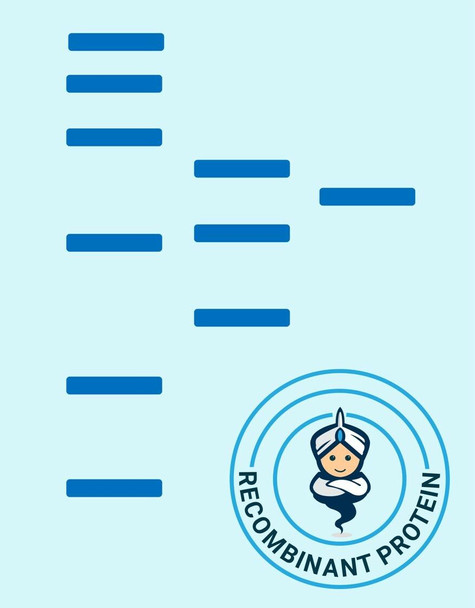Description
| Product Name: | Human UBL5 Recombinant Protein |
| Product Code: | RPPB5069 |
| Size: | 20µg |
| Species: | Human |
| Target: | UBL5 |
| Synonyms: | Ubiquitin-like protein 5, HUB1, FLJ46917, MGC131795. |
| Source: | Escherichia Coli |
| Physical Appearance: | Sterile Filtered clear solution. |
| Formulation: | UBL5 protein solution (1mg/1ml) containing 20mM Tris-HCl buffer (pH8.0), 20% glycerol, 0.1M NaCl and 2mM DTT. |
| Stability: | UBL5 although stable at 4°C for 1 week, should be stored below -18°C. Please prevent freeze thaw cycles. |
| Purity: | Greater than 90.0% as determined by SDS-PAGE. |
| Amino Acid Sequence: | MGSSHHHHHH SSGLVPRGSH MIEVVCNDRL GKKVRVKCNT DDTIGDLKKL IAAQTGTRWN KIVLKKWYTI FKDHVSLGDY EIHDGMNLEL YYQ |
UBL5 is believed to be a reversible modulator of protein function unlike ubiquitin which is a protein degrader. UBL5 influences a nuclear phase obligatory for increasing a reaction against the risk of mitochondrial protein misfolding.
UBL5 Human Recombinant produced in E.Coli is a single, non-glycosylated polypeptide chain containing 93 amino acids (1-73a.a) and having a molecular mass of 10.7kDa.UBL3 is fused to a 20 amino acid His-tag at N-terminus & purified by proprietary chromatographic techniques.
| UniProt Protein Function: | UBL5: a widely expressed and highly conserved protein. Orthologs of UBL5 occur in all characterized eukaryotic genomes. Specifically interacts with CLK4. |
| UniProt Protein Details: | Protein type:Ubiquitin-like modifier Chromosomal Location of Human Ortholog: 19p13.3 Cellular Component: cytoplasm; nucleus Molecular Function:protein binding; protein tag Biological Process: nuclear mRNA splicing, via spliceosome; protein modification process |
| NCBI Summary: | This gene encodes a member of a group of proteins similar to ubiquitin. The encoded protein is not thought to degrade proteins like ubiquitin but to affect their function through being bound to target proteins by an isopeptide bond. The gene product has been studied as a link to predisposition to obesity based on its expression in Psammomys obesus, the fat sand rat, which is an animal model for obesity studies. Variation in this gene was found to be significantly associated with some metabolic traits (PMID: 15331561) but not associated with childhood obesity (PMID: 19189687). Pseudogenes of this gene are located on chromosomes 3, 5 and 17. Multiple alternatively spliced variants, encoding the same protein, have been identified. [provided by RefSeq, Jan 2013] |
| UniProt Code: | Q9BZL1 |
| NCBI GenInfo Identifier: | 52082771 |
| NCBI Gene ID: | 59286 |
| NCBI Accession: | Q9BZL1.1 |
| UniProt Secondary Accession: | Q9BZL1,Q2NL89, |
| UniProt Related Accession: | Q9BZL1 |
| Molecular Weight: | 8,547 Da |
| NCBI Full Name: | Ubiquitin-like protein 5 |
| NCBI Synonym Full Names: | ubiquitin like 5 |
| NCBI Official Symbol: | UBL5�� |
| NCBI Official Synonym Symbols: | HUB1�� |
| NCBI Protein Information: | ubiquitin-like protein 5 |
| UniProt Protein Name: | Ubiquitin-like protein 5 |
| UniProt Gene Name: | UBL5�� |
| UniProt Entry Name: | UBL5_HUMAN |








